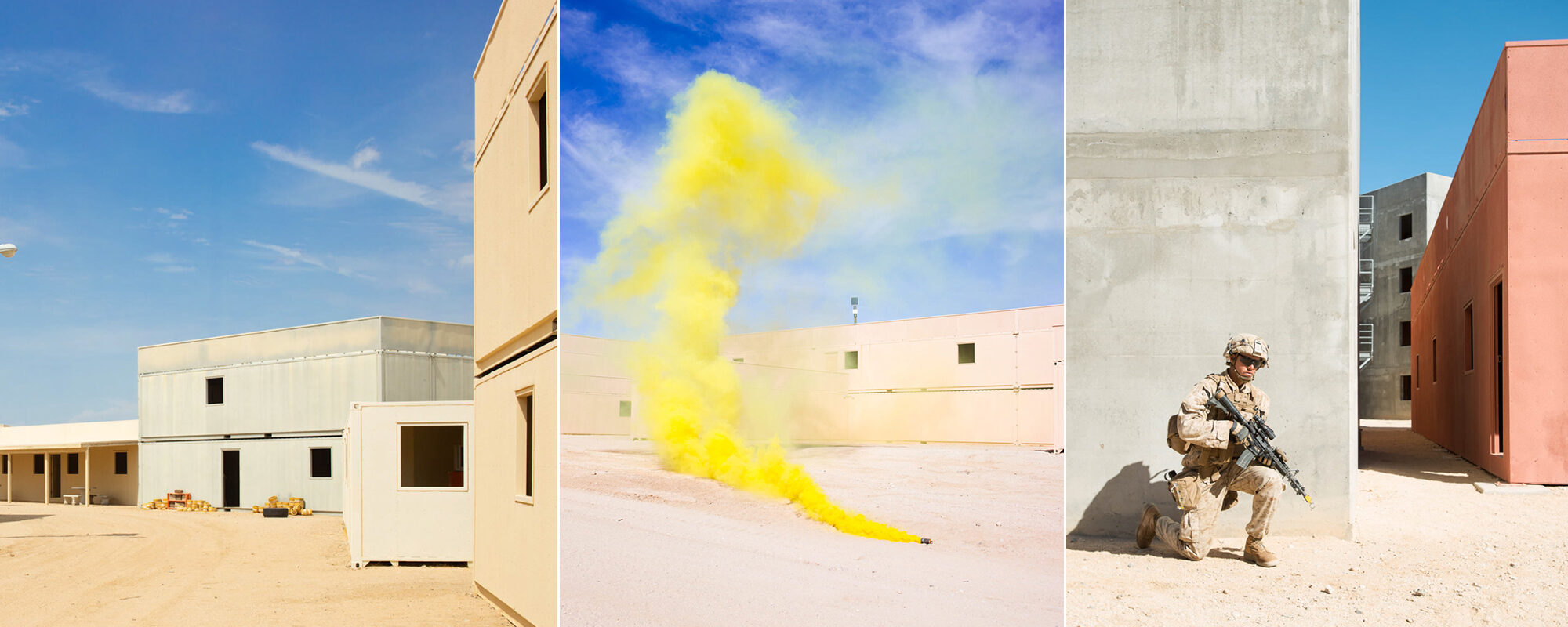“The phrase “necessary fictions” both characterizes state-created realities, whether simulation in the military training context or the deployment and consumption of fictions in civilian society, and also comments on the documentary form.”
Debi Cornwall’s Necessary Fictions intersects a couple of tropes in documentary photographic enquiry. Initially it took me back a few years ago when there was a great deal of work being made about the post 9-11 landscape of conflict, the interface between war and technology, and how visual culture and photography played a role in defining the theatre of war but also the challenges it presented in depiction and representation. I keenly remember the works of Lisa Barnard, Jananne Al-Ani, Sophie Ristelhueber amongst more discussed others. The second trope was about the movement of documentary towards a conceptual trajectory, which also involved a degree of self-reflexivity, construction and fiction (partly in response to said issues around representation) reflecting strong elements of research within the work. Perhaps as evinced in the practices of Sim Chi-Yin and Amak Mahmoodian.
These trajectories centralise the medium in amongst the subject-matter, which is an interesting thought. However, in most of these cases the self-reflexivity washes over the work instead of being so invasive that it becomes an overriding concept. There is the pull and push of how the artistic sensibility plays with its documentary status. Like many of these artists, Debi finds her own position and invokes it with care, collaboration and critical depth. I was interested in finding out more and so engaged in the following conversation over some emails.
Sunil Shah: Can you give me a little introduction about yourself, your practice and tell me how and when this project started? What were the motivations behind working on such a photographic project?
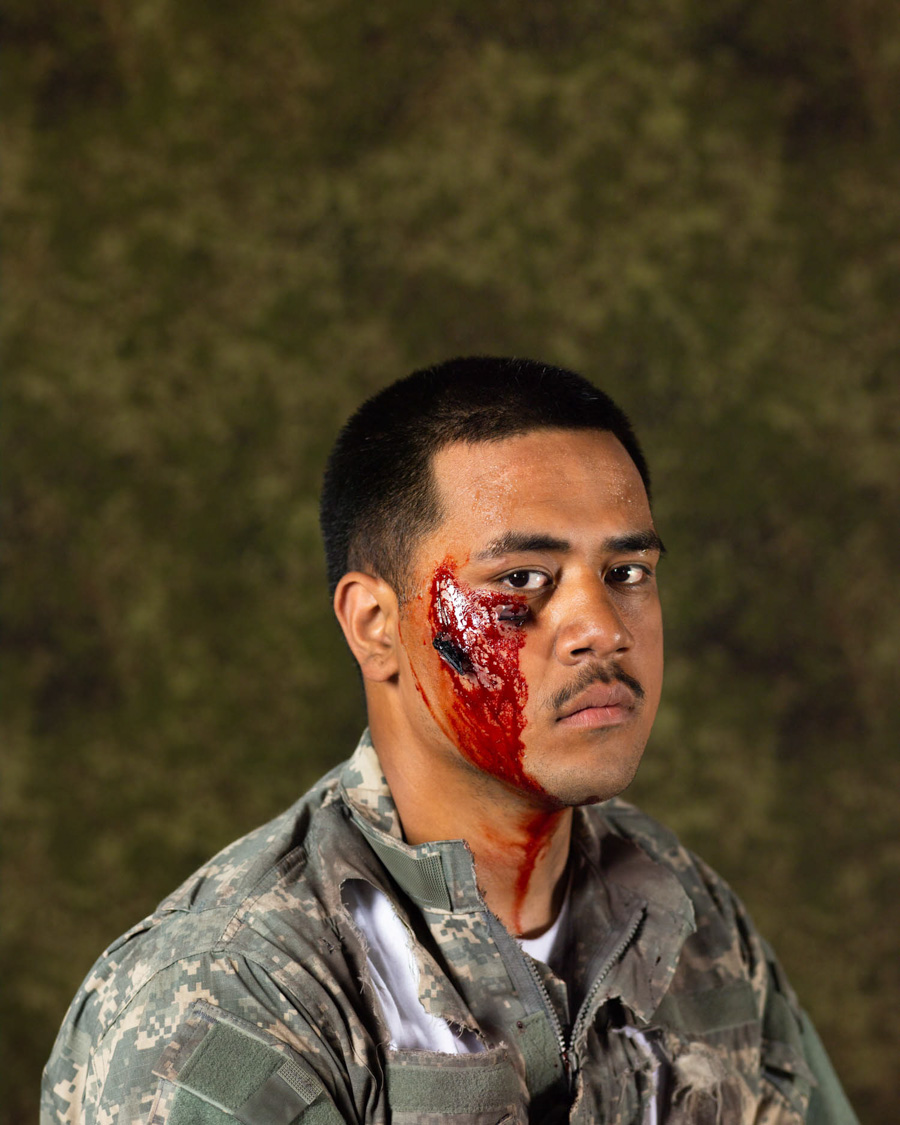
Debi Cornwall: I am a conceptual documentary artist who returned to visual expression in 2014 after a 12-year career as a civil-rights lawyer. My practice uses photography, sound, film/video, testimony, and archives. Necessary Fictions arose out of my first project, Welcome to Camp America: Inside Guantánamo Bay (Radius Books, 2017). Visiting “Gitmo” three times in 2014-2015 was the first time I had personally encountered a place where reality was so manifestly stage-managed for public consumption. The U.S. military controls who may visit the U.S. Naval Station in Guantánamo Bay, Cuba, and what they can see once they arrive. As press, I was accompanied at all times by military escorts, who did double duty as censors. In daily “Operational Security Review,” my photographs were scrutinized for compliance with the lengthy rules; any image deemed to violate them was deleted. The messaging was quite blunt: “Gitmo is the best posting a soldier could have,” my military escort told me. “There’s so much fun here!” Not what I had expected to hear. Since I would not be shown what was really happening behind closed doors, I decided to look at what I was being asked to see: the fun show. During these visits I spent long days in the company of military escorts, and asked about their experiences. Many had previous active-conflict deployments, and all were still dealing with the effects. I became curious about how humans wrap their heads around preparing for war. So in the summer of 2016, when the WCA book design was underway, I started researching military training. And I found an extensive network of immersive, realistic military training scenarios playing out among mock villages on American military bases, populated by costumed Afghan and Iraqi civilian role-players. Later, while doing research for the book, I came across the shockingly candid 2004 quote from Karl Rove, President George W. Bush’s chief political strategist (“We’re an empire now, and we create our own reality”), and it all came together for me: my practice examines American state-created realities.
SS: How has your previous career and experience as a civil-rights lawyer shaped the approach and content of your practice? Both in different ways, as you put it, “examine state-created realities”. Is the departure from the legal to the documentary or artistic mode a personal one and is it connected to going places the previous profession could not go? It is an interesting transition but one I completely understand, myself having worked most of my life within the apparatus of civil governance.
DC: Initially I thought I had left the law behind for good. Though I loved fighting for justice on behalf of innocent DNA exonerees and families of men fatally shot by police, and treasured the bonds I formed with my clients, I was solving the same problems day after day, within an ever-narrowing range of legal limitations. Our cases offered the promise of systemic reform (and sometimes succeeded), but they never seemed to get to the emotional reality of what had gone wrong. The legal system isn’t built for that. I left the law in hopes of living differently, having more room at day’s end. Coming back to visual expression—photography, and now sound, film, and video—was about looking at some of the same questions, but fuelled by curiosity rather than outrage.
A lawyer’s job is to distil evidence into a compelling narrative from which only one conclusion can be reached. In my cases, that meant right or wrong. But in the real world nobody wants to be on the wrong end of a wagging finger. My practice now is about trying to understand complex systems and how they affect us, using my explorations as a way to disrupt assumptions and invite critical conversation among a much wider audience than I reached as a lawyer. Now it’s about posing questions more than answering them. Art can resonate with people in ways the law cannot. Art can spark a visceral reaction, and that can be the start of a conversation. As I’m sure you’ve found, both the focus and methodology of my visual practice are heavily informed by my past work. Research and negotiation were critical to my advocacy and remain integral to my practice as an artist. I want to understand how power operates, how it affects us. But now I use unexpected or jarring images, often not depicting the thing itself, to beckon viewers in through the side door and join me in grappling with these questions.

SS: Although I think to a certain extent, art audiences are cossetted and form a community of consensus and I often find it hard to see how far our world reaches “the everyday”. That being said, I do believe that it is one of the few spaces that allows a breach of “the everyday” and hence open up questions that are not posed otherwise. And ultimately, I think ideas explored in art and especially experimental visual culture find themselves eventually seeping into the mainstream, so I think it has an important role to play. It offers self-reflexivity as well as a scope of possibilities and speculative thought. I had an interesting discussion with Max Pinckers about this. In fact, your work feels to me like it operates in this post-documentary terrain, where it is not about representation per se but about questioning the subject matter you are highlighting, its problems and its contradictions. How easy is it to work in this way, do practical solutions come about easily in the production and editing process or do they take a great deal of working through? Can you give some examples as they appear in the book?
DC: Well put. Seeing how state power operates through fictions has led me toward this kind of approach. You could call it post-documentary. I’m fascinated by Max Pinckers’s practice and ideas about speculative documentary. I’ve used the somewhat less descriptive term, conceptual documentary. When making photographs of “documentary subjects” like Guantánamo or war(games), we are primed to envision a certain kind of image, in a certain kind of form, telling a certain kind of story. That received expectation is powerful. Often, embedded within it are a bunch of suspect assumptions about photographs as truth documents that can effect change. Too often, that way of working leads to what I think of as the feedback loop of empathy: see an essay on suffering people, feel badly, pat oneself on the back for having felt empathy, and voilà, our work is done! For the viewer, it’s a closed loop rather than an open door.
While labels can be limiting, they can also help recalibrate expectations about what the work is about, the process behind it, and what it’s offering and asking of the viewer. Aside from the gift-shop souvenirs from Guantánamo Bay, perhaps, you probably wouldn’t understand what most of my photographs depict, or more fundamentally what they are about, absent more information. The images are not an end in and of themselves. They are one means among many to spark inquiry. Context is critical.
With Welcome to Camp America, I was clear about what I wanted to do, and how. I methodically developed each body of work, one at a time—from the home and play spaces of prisoners and guards at “Gitmo,” (the “fun” show), to the souvenirs (the commodification of state power), to the environmental portraits of men cleared and released around the world (the denial of personhood persisting long after the body is freed)—so that each would be a complete thought. I added context later, layering the photographs with declassified documents on the bureaucratization of violence, testimony, and other materials.
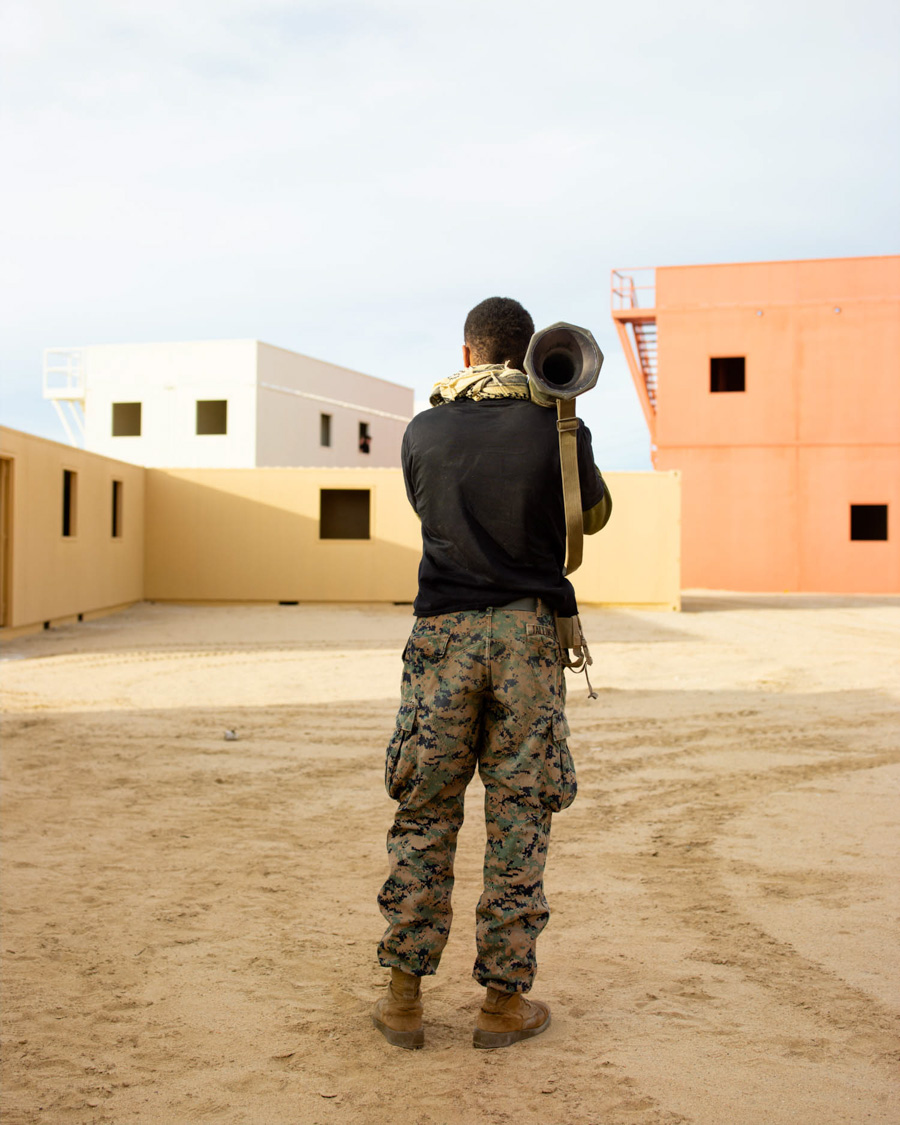
In Necessary Fictions things evolved more organically over time. At first, I was just intrigued by the staging and performance of state fictions through wargames. Casting costumed Afghan and Iraqi civilians, many of whom had fled war, as role-players enacting versions of their past lives in military wargames? Plenty to unpack there. Flying in Hollywood makeup artists to dress real soldiers in fake wounds (“moulage”) in a dress-rehearsal for their possible futures as casualties of war? Whoa. In each of the ten military sites I visited, some multiple times, I started by trying to understand the systems in play. This was practical—what is going to happen, who is in charge, and who can get me access—and also helped create a framework for understanding. Over time I realized I was more curious about the systems in play, as well as the context in which these games take place, than making literal representations of the wargames themselves. What is going on here? How did this become normalized? What does this have to do with us? What does it say about American society? A society in which perpetual war abroad begets entire industries at home, where fictions have so infused our civic life that we have trouble discerning fantasy from reality?
As I continued to make photographs my research expanded. I came across an incident that I use as a case study in the book: Without giving too much away, “Pineland” is about a traffic stop in which distinguishing fantasy from reality became the difference between life and death. The story, told through excerpts of testimony from the survivors as well as evidence from the case, is inserted as a booklet within Necessary Fictions. It works narratively on a representational level but also poses larger questions about American militarism and how state fictions operate and affect us on a practical level. How (white) Americans are primed to divide the world into good guys and bad guys, with ourselves always cast as the hero. What happens when those simplistic assumptions are shattered? (I’m now in the process of adapting the Pineland story, in collaboration with one of the survivors, into a collection of moving-image pieces in multiple genres, each focusing on a different aspect of the systems in play.)
I spent about a year developing the text between two quotes that open and end the book. First, the remarkably candid Rove comment about the American government: “We’re an empire now, and when we act, we create our own reality.” And the last, from novelist Ben Fountain, who was kind enough to share with me a speech he gave at the U.S. Air Force Academy in which he coined the phrase, “fantasy-industrial complex.” Our officials lie to us, but we also embrace fictions to manage or distract ourselves from unsettling truths. In substance and in form, the work needs to reflect these complexities. So I juxtapose and layer images with texts that careen across genres: advertisements, testimony, news reports, psychological studies, a TV script, employment contracts, first-person accounts, political speeches, unverifiable stories, and my own subjective interactions with the players and more personal musings. I’m trying to understand overlapping ecosystems, organize the noise, and highlight multiple facets of a fractured whole. The systemic and the personal. The poignant, heartbreaking absurdity of it all.
This way of working rewards a viewer’s sustained attention. You’ll get more out of it if you read it from start to finish. It’s an invitation, and also a challenge.
“My practice now is about trying to understand complex systems and how they affect us, using my explorations as a way to disrupt assumptions and invite critical conversation among a much wider audience than I reached as a lawyer.”
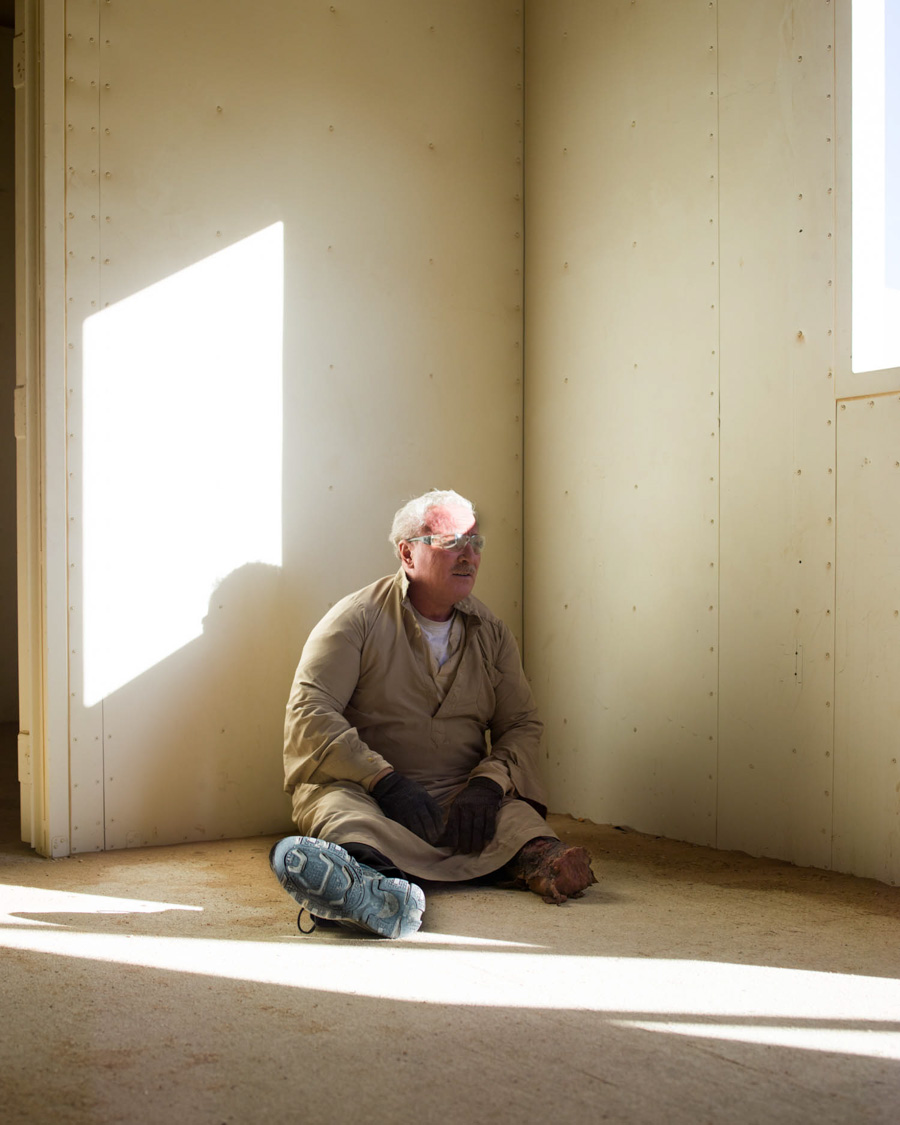
SS: I think it is a book that rewards, the deeper you look the more you find. It is sizeable and weighty, and certainly testament to the many layers of research, images and text that you intensively worked through. I feel that it needs this weight to it, like any long-term research project there is much collated and it must have been a challenge to distil this work into its final form, although I see for you the project is far from finished. The book is divided into chapters which seem to begin at a distance (a location) and then focus in towards the human and towards interaction, all the while there are segments of text slowly unravelling more information, until the end where images make way for only text. This is a clever way of reflecting the way in which a viewer might fall deeper into the work in the same way you must have done as the project became more complex and more multi-layered. What became the strategy for deciding to arrange the material you were collecting into the sequence of the book and its eventual narrative form?
DC: Sequencing for the book began with the text, which evolved organically over time to have its own arc and rhythm. My textual research grew out of the ideas “state-created realities” and “fantasy-industrial complex.” And it was just like learning any new word or concept: once you’ve been introduced to it, you find it everywhere—in ads, in scripts, in news, in official policy, and real-world examples. I also steeped myself in fictional stories of state violence, reading and watching everything I could find. (There is obviously no shortage there.) Ben Fountain’s novel, Billy Lynn’s Halftime Show captured the dark absurdity of it all, and it was important for me to include that unsettling hilarity. And I decided to write more personally than I have before, not as an authority, but as another subjective player balancing a public-facing role with an internal set of questions, experiences, ideas, and concerns.
As I was writing and gathering all this material, I feared I would have to choose a direction, find a limiting principle and edit out the rest. Then a friend recommended Sarah Sentilles’s genre-defying book, Draw Your Weapons. It was a revelation. Short chapters jump from one subject to the next, juxtaposing apparently disparate stories—memoir, history, war, psychology, photography—that eventually emerge as parts of a larger whole. Colum McCann’s Apeirogon, which fictionalizes the true stories of a pair of fathers, one Palestinian, one Israeli, who came together after losing their children, operates in a similar way: fractured, nonlinear. I realized that this collaged form of writing tracks the way I am thinking about these questions, mapping out systems that initially appear distinct but in fact are very much connected.
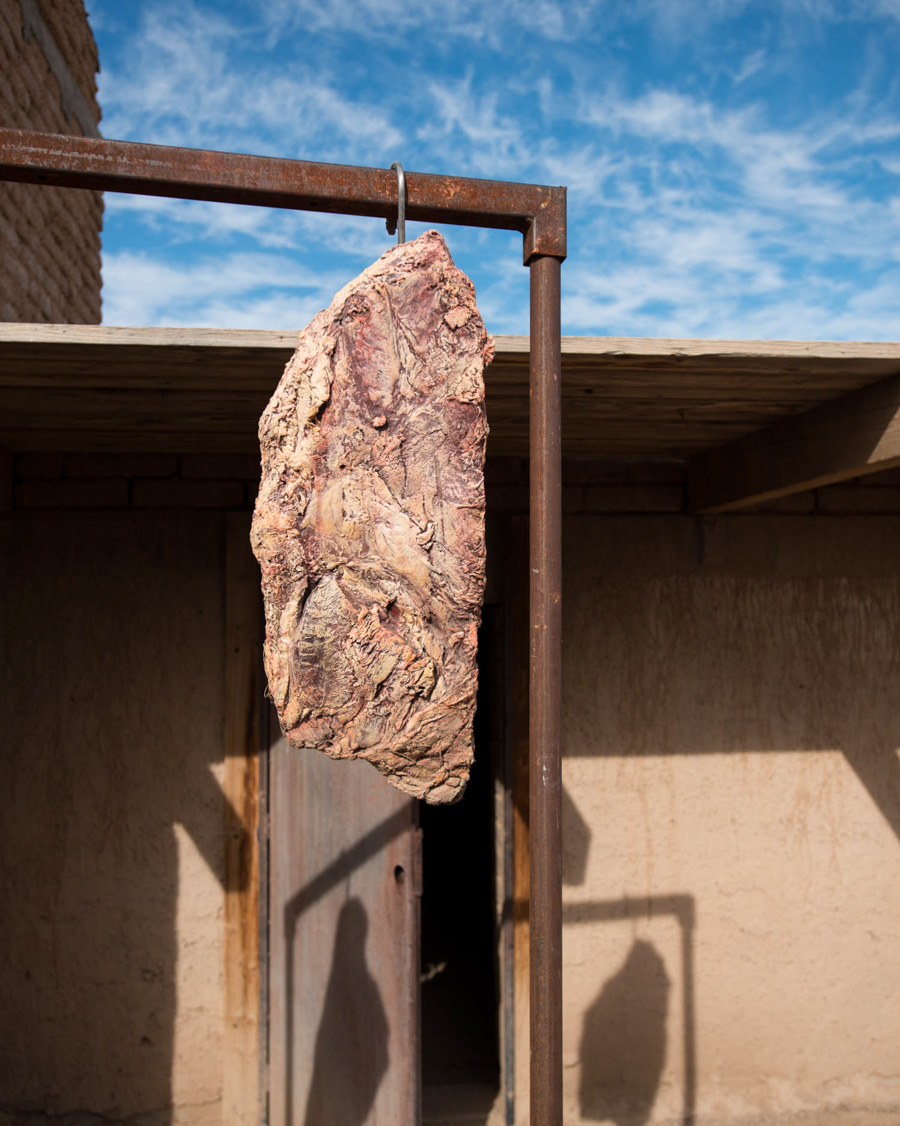
The same philosophy motivated my choices for the back matter. Rather than one critical essay, I wanted to include a variety of genres. So we have poetry by anthropologist Nomi Stone, who did her field work in these sites; original fiction by Iraq War veteran Roy Scranton, and essays by curator Makeda Best and Sarah Sentilles.
When I arrived at Radius Books to work with my publisher and designer, David Chickey, my text was close to final. But the image sequencing was not. You never want to be that person who turns up with a pile of photographs, but I must admit that was me this time. We covered every flat surface in the studio, and went back and forth on ideas for the structure. Depending on the edit, the book could go in a number of directions. Emphasize the faux-photojournalism action of the scenarios or the uncanny staging, the simulacrum? Ultimately, the point is not to make a Where’s Waldo (are we in Iraq? Afghanistan? Find the real soldier!), but to emphasize the imperfect staging and performance.
Structurally the book gestures in the direction of a country report issued by the government. The games play out in the fictional country of Atropia, so Necessary Fictions works like an introduction for the first-time traveler. (Of course, in looking at Atropia, I am looking at the mythology of America.) We begin at the macro level—Location, Resources, Population—and work closer and closer to the intimate heart of this place, ending with Casualties, the graphic portraits, paralleled by texts about the intimate psychology of war for all involved. Once we defined those chapters, it all fell into place.
As seems to be the way with me, there were a couple of ideas that were related, but did not quite fit into this structure, so we used design to set them off in their own categories: the Pineland booklet case study, and also the smiling moulage photographs, laid out as school yearbook pages, tucked into an envelope inside the back cover.
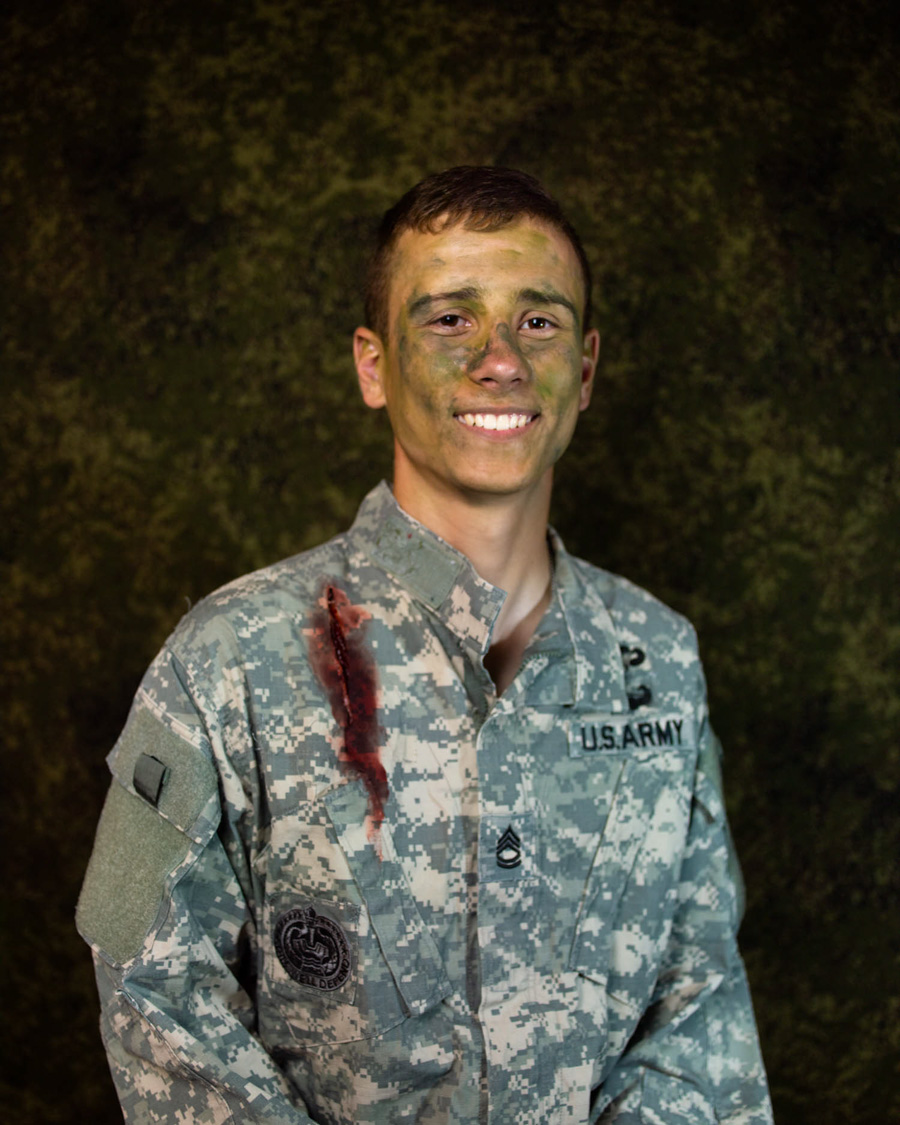
SS: The title alludes to the required fictions that we use in the documentary mode to help convey stories or certain truths that exist, but more directly to the creation of the simulation, in training and preparation for the theatre of conflict. Theatre is an interesting term in this respect as in this case the stage is set for acting, make up and scenes which are to be played out by the “players”. Elements of the ‘make believe’ are actually very realistic, especially the extent to which the simulation is made real, to the fine detail, replicating smell as well as visual realism. Still, the sets feel like an abstracted world, there is nothing superfluous that takes the attention away from the objectives/targets. Military operations are now very close to the way computer games are played, for example drone strikes being operated remotely, yet they still have the power to affect. I am reminded of the film by Omer Fast, 5000ft is the Best (2011), where the psychological effects of modern warfare create trauma and mental dislocation even though the ‘enemy’ is not directly engaged with. I wonder about the individuals in Necessary Fictions, their experience and mental projection of this?
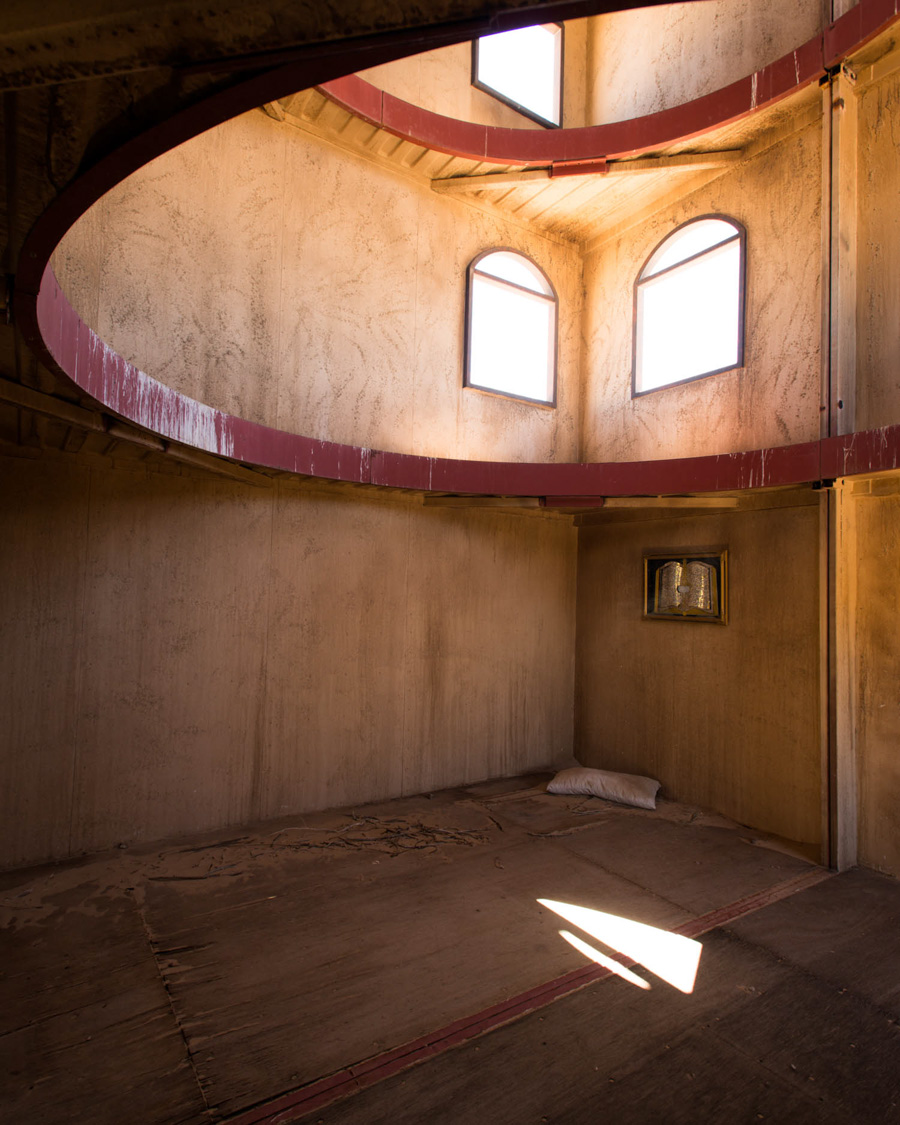
DC: The phrase “necessary fictions” both characterizes state-created realities, whether simulation in the military training context or the deployment and consumption of fictions in civilian society, and also comments on the documentary form. That’s the direction of my research and teaching now—how fictions may infuse documentary work, and how visual artists working across genres use fictions to tap into “documentary” truths. These states of exception, these interstitial spaces, whether the mock-village training sites or the official messaging at Guantánamo, are ripe for exploring the role of fictions in society and documentary practice.
I wonder about this too, how the games are affecting the players. I’ve read the studies and conceptually understand the notion that repetition in realistic scenarios creates sense-memory, which kicks in under traumatic circumstances in ways that merely memorized responses do not. But at what cost? As I write about in the book, I am skeptical that the training to limit physical trauma can do so without imposing psychological trauma, whether in the military training context or school shooting drills. Entire industries have grown up around both. Is it worth it? Is it helping? Is this intervention even identifying the right problem? It all takes war, shooting, militarism as a given. Have we lost the forest for all the shiny simulated trees?
I’ve spoken to players, both civilian and military, about their experiences of these simulations. When I asked the “moulaged” soldiers how it felt to be dressed this way, on the eve of deployment, their answers ran the gamut. Some took it in stride as part of the job, a few seemed shocked to contemplate the reality of what they had gotten themselves into, and still others played it off as a joke. But I’m not sure if self-reporting is capable of answering the question. Aside from whether or not I was in a position to engender trust in a few minutes to elicit authentic responses, we may all tell ourselves fictions to manage unsettling truths, no? Or put on a public face that may differ from our internal experience. (I am reminded of sociologist Erving Goffman’s classic Presentation of Self in Everyday Life here.)
Omer Fast’s work is a perfect example. In 5,000 Feet is the Best, he casts an actor to reenact an interview Fast had with a real drone operator. The reality of his trauma emerges from the dramatization. Not so much in the words themselves, but in the body language, the questions evaded, the insistent cuts to the imagined drone’s-eye POV over an ambiguous landscape below, the repeated escapes to a hidden pack of cigarettes in the hallway. In Necessary Fictions, rather than reporting on interviews with the players or positing them as facts, I’m framing those subjective, anecdotal interactions as elements within a constellation of fictions from which larger truths may emerge.
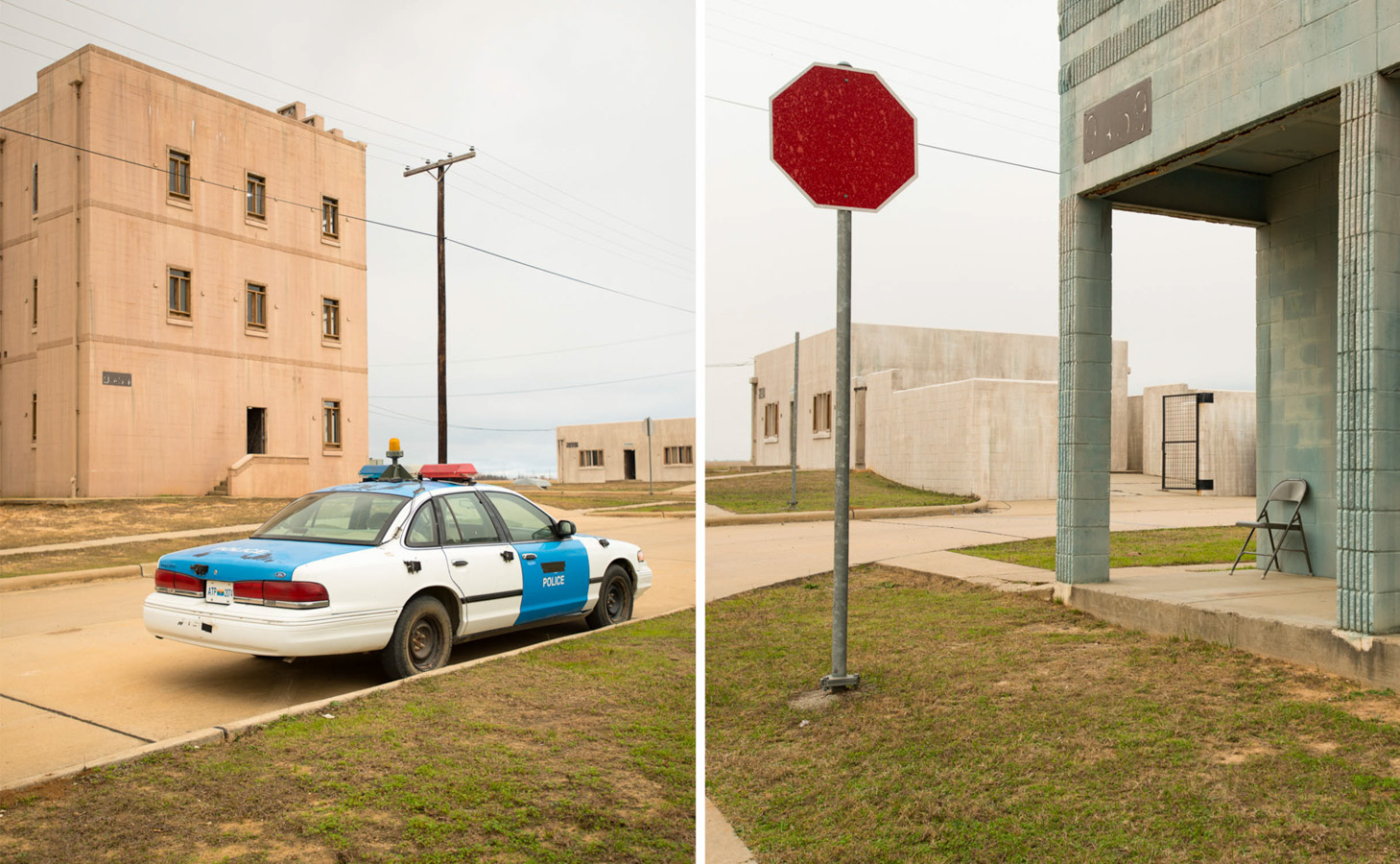
SS: I’d like to switch to contextual aspects of the book, especially what is connected to the ‘Military Industrial Complex’ or the ‘Fantasy Industrial Complex’, both terms are connected as we relate one to the economic and industrial production and propagation of the war and conflict across the globe to its commercial and consumerist manifestation. War is something I think is deliberately and intimately tied into national myths and the maintenance of a national identity. In the UK, so much seemingly everyday rhetoric harks back to the war efforts of the world wars in the 20th Century, we hear this in the workplace, on mainstream media, throughout the entertainment industry and in politics, most recently noted in the way the UK government sustains a language reminiscent of the ‘The Spirit of the Blitz’ in its appeals to the nation regards their public duty towards Brexit, terrorism, Covid and the new threat of a unified Europe. This is stretching the use of these terms somewhat, but it shows how far they filter into what is perceived as the norm. Throughout your work and research, these terms have guided you, very directly, but how have you found these terms seeping into the everyday in the US?
DC: There’s so much to unpack here. The term “military-industrial complex” was coined to describe how the financial relationship between the federal government and huge “defense” corporations fostered war abroad, but it now describes the militarization of domestic police. Since 9/11, the “1033 program” (enacted in 1997) has ramped up police militarization by selling billions of dollars-worth of excess military equipment to local police departments. Between that and “warrior”-style training, it’s now often hard to distinguish police from an invading army. At the same time, policing is rapidly becoming privatized in “militias” who, relying on a myopic reading of the Second Amendment to the exclusion of all the other constitutional provisions, are increasingly emboldened to gear up, arm themselves, and deploy en masse to “monitor” or “regulate” other civilians, whether they are voting, counting ballots, or protesting police violence.[1] Domestic militarization has become so prevalent that it’s now white noise, to the point where it was newsworthy when Walmart, the national department store chain, stopped selling ammunition in the runup to the election.
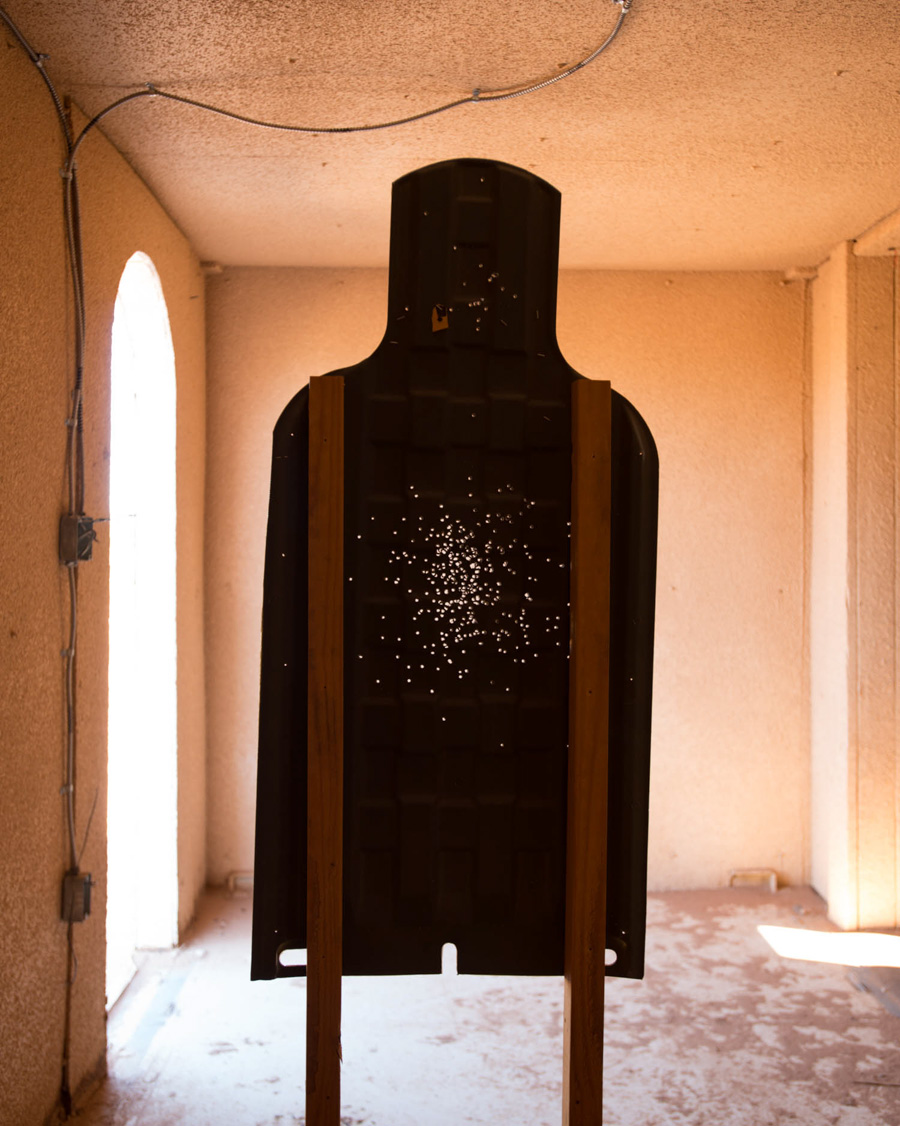
For sure, this is all connected to (exploited by?) myths around national identity. Just as in the U.K. the “Spirit of the Blitz” is repurposed as anti-EU, antiterror ethno-nationalism, we have American exceptionalism, this idea that we are different, better, than anyone else. That we are winners whose history and destiny somehow immunizes us from suffering, illness, or a breakdown in the democratic process. I finished the book pre-COVID (we printed in Northern Italy just before things exploded there), but obviously the pandemic context is all-pervasive now. One thing we aren’t getting from our top federal officials during the pandemic is any “we’re all in this together,” “sacrifice for the good of us all” kind of messaging. Instead, we have a patchwork of responses to two diametrically opposed realities. The Venn diagram has no overlap between the half of the population taking the threat seriously and the half who see COVID-19 as a hoax or basic public health measures as an assault on their liberty. It has so much to do with how we conceive of our national identity and role as citizens. Who are “we” anyway?
Meanwhile, magical thinking abounds. It’s almost impossible for us to understand each other, much less convince each other of anything, because our reference points, our information sources, our worldviews, occupy different dimensions. We are, collectively, prisoners of confirmation bias: we see reality through the lens of what we believe, and organize the evidence to bolster our sense of what is, rather than to test it. We choose our own facts. All the rest gets blocked out.
The fantasy-industrial complex feeds these divisions by urging us to work harder, buy more, and it’ll be ok. As a people, we are buying into that messaging. So we consume. Gun sales are booming. Amazon’s profits have tripled during the pandemic as those who can afford to work at home have life delivered to their doorsteps. Amazon’s billionaire owner has become stratospherically richer. Its employees, now deemed “essential” along with first responders, food industry workers and teachers, work harder with fewer protections but much higher physical risk, and no safety net. Amazon is one example, but it exemplifies how we are increasingly stratified into profiteers, haves, and have-nots.
At the same time, our online culture is an all-consuming distraction. Crafting, liking, or sharing the snarkiest post becomes an end in itself, resonating within a siloed community while feeding a gaping maw of corporate surveillance. Maybe binge-watching replaces doomscrolling. But comfort breeds complacency. Social media and other online platforms have so much to offer. They help us organize, and connect. They can offer a respite from our dark realities, a release in witty retorts, memes, or Tik-Tok videos. But the real work happens offline.
By illuminating these interlocking systems, I hope Necessary Fictions can contribute to a collective process of questioning and perhaps recalibrating what it means to be an American.
[1] See, for example, the McCloskeys in St. Louis, white residents in Indiana brandishing assault weapons, and Kyle Rittenhouse, the white teen who shot three Black Lives Matter protesters in Kenosha, Wisconsin, killing two, who later crowdsourced $2 million to secure his release on bail pending trial. All of this is an escalation of a long, racialized history in the U.S., as predictable as it is shocking.
Debi Cornwall
Necessary Fictions
(All Rights Reserved. Text @ Sunil Shah & Debi Cornwall. Images @ Debi Cornwall.)
